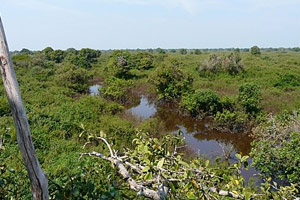Magazine | Voyages
Le Tonlé Sap, un lac unique

Prek Toal, Tonlé Sap, janvier 2011.Photographie : Arnaud Delberghe
Introduction
Le Tonlé Sap est le plus grand lac naturel d’eau douce d’Asie du Sud-Est, et il a été désigné comme Réserve de Biosphère par l’UNESCO en 1997 pour sa valeur écologique, économique, sociale et culturelle. Il est relié au fleuve Mékong par la rivière Tonlé Sap.
Sa superficie pendant la saison sèche (de février à mai), de près de 2 700 km² pour une profondeur d’environ un mètre, est quasiment multipliée par six quand arrive la mousson. Quand la profondeur du Mékong dépasse environ les neuf mètres, ses eaux affluent dans la rivière Tonlé Sap, provoquant de grandes inondations.
Ces inondations cycliques sont à l’origine de la grande richesse naturelle du secteur. On y trouve en particulier des forêts et des prairies inondables importantes pour de nombreuses espèces d’oiseaux.
Nous remercions Bruno Tredez (http://bruno.tredez.com) et Arnaud Delberghe (http://notjes.over-blog.com) pour nous avoir aidés à illustrer cet article.
Abstract
The Tonle Sap Lake is one of the largest freshwater lakes in Asia, swelling to an expansive 12,000 km2 during the wet season. During the dry half of the year the Lake shrinks to as small as 2500 km2, draining into the Tonle Sap River, which meanders southeast, eventually merging with the Mekong River at the ‘chaktomuk’ confluence of rivers opposite Phnom Penh. But during the wet season a unique hydrologic phenomenon causes the river to reverse direction, filling the lake instead of draining it. The engine of this phenomenon is the Mekong River, which becomes bloated with snow melt and runoff from the monsoon rains in the wet season. The swollen Mekong backs up into the Tonle Sap River at the point where the rivers meet at the ‘chaktomuk’ confluence, forcing the waters of the Tonle Sap River back upriver into the lake. The inflow expands the surface area of lake more than five-fold, inundating the surrounding forested floodplain. The seasonally inundated forests and grasslands are unique and very important for numbers of birds, but they are threatened by the agriculture.
Poursuivez la lecture de cet article, en vous abonnant dès maintenant !
Découvrez les Archives d’Ornithomedia.com
Pour seulement 10,00 €TTC/an (ou 6,00 € les 6 mois)
Profitez de plusieurs centaines d’articles en accès illimité et sans aucun engagement.
Compléments
À lire sur le web
- Le séjour illustré de Bruno Tredez au Cambodge en novembre 2010 sur http://bruno.tredez.com/
- Le séjour illustré d’Arnaud Delberghe au Cambodge en janvier 2011 : http://notjes.over-blog.com/article-cambodge-janvier-2011-69619570.html
- Le site web de la Wildlife Conservation Society au Cambodge : www.wcscambodia.org
- Un récit d’un séjour à Angkor, Tonle Sap et Mondolkiri en 2009 : http://www.chezfred.info/ornitho_KHM.php
Ouvrages recommandés
- Birds of South-East Asia Craig Robson
- A Field Guide to the Mammals of South-East Asia Charles Francis
- Periplus Travel Map Cambodia: Country Map Periplus Editions
- Guide du Routard Cambodge, Laos 2012 Collectif
Sources
- Canby. Tonle Sap Lake and the Prek Toal Bird Sanctuary. http://www.canbypublications.com/siemreap/srtonlesap.htm
- Birdingpaltours (2011). Birdingpaltours around the world. Birdwatching in Cambodia. http://www.birdingpal.org/tours/CambodiaItinerary.htm
- Birdlife International. Boeung Chhmar / Moat Khla. http://www.birdlife.org/datazone/sitefactsheet.php?id=16666
- Peter J.A. Davidson (2006). The biodiversity of the Tonle Sap Biosphere Reserve 2005 status review. http://www.tsbr-ed.org/docs/reports/comp3/Peter%20Report%20Final%20JSRC%20OK.pdf




Aucun commentaire sur ce sujet
Participer à la discussion !